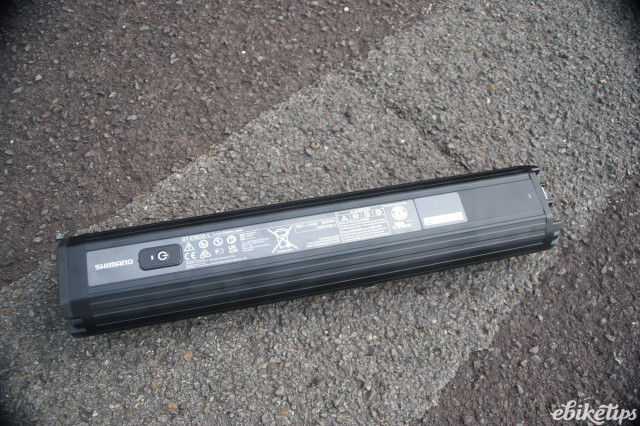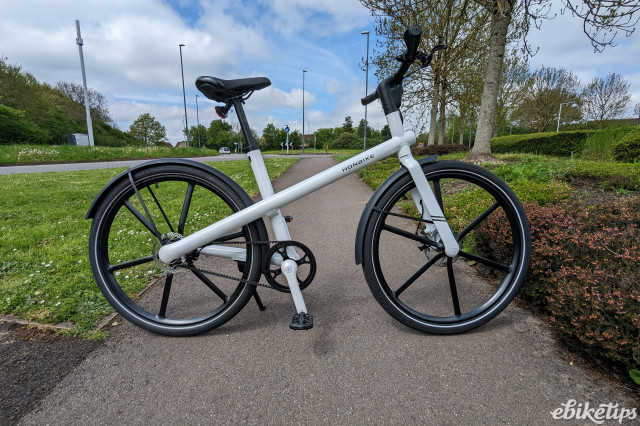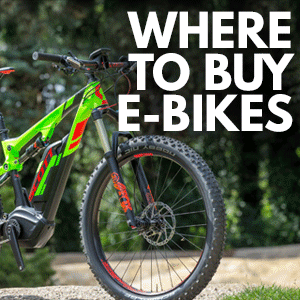Review: Merida eSPRESSO City 400 EQ
Overview
- Good range
- Smooth power delivery
- Loads of accessories
- No lock-out on fork
Merida’s eSPRESSO City 400 EQ is designed primarily for urban use, but with front shocks, wide tyres and a suspension seatpost it is just as happy on by-ways, canal paths and woodland forest tracks as it is popping to the shops or taking care of the commute. With loads of accessories included you’ll not need to factor in any extra cash for those either.
Ride
The eSPRESSO is a joy to ride straight out of the box, and for me at least I didn’t feel that it required any acclimatisation to how it behaved compared to a standard flat-barred urban bike. It handles well and although it is heavy, the way that weight is positioned means that the 400 EQ never becomes a handful even at slow speeds.
If you do have to make a slow, tight turn in traffic for instance, or navigate through barriers on the cycle path, the low step-through frame design means that you can easily slide off of the saddle should you need to dab a foot down.
For a bike with a wheelbase of 1,169mm (size large) it still feels relatively nimble too when you change direction, and its turning circle isn’t too bad either.
The front end gives a tall ride position, even with the adjustable stem pointing level with the ground, which gives you good sight lines in traffic and a relaxed feeling through your back and shoulders as you are riding along.
The furthest distance I covered in a day was a 50-mile round trip to visit family and I found the Merida to be very comfortable. I used a mixture of back lanes and by-ways and it just floated along on its 50mm tyres, backed up by the front suspension fork and seatpost for added protection from the rough bits.
The fork offers 63mm of travel and it works well, although when on smoother rides I did find it a bit soft. This brought a vague feeling to the steering, while the front-end dips quite a bit under braking.
You can play about with the damping a bit by way of hex key adjusted units under the plastic caps on the top of each leg, but you can’t lock it out completely which I would have preferred.
The hex key slots are made of plastic too, so they are easy to round off – once you have found your preferred damping, you are best off leaving it alone.
The seatpost isn’t too saggy when you are sat on it, so you won’t find yourself bouncing around too much in the saddle.
Motor and battery
Merida’s choice of a Shimano Steps E6100 drive unit is a good one as it works very well, complementing the comfort and relaxed nature of the eSPRESSO.
With 60Nm of torque on offer, the Merida has plenty of poke for quick acceleration up to the 25km/h limit and it’ll tackle all but the steepest of climbs before it starts to run out of puff. There are torquier motors out there, but the Merida handles itself well.
Coupled with the 504Wh battery the whole motor system seems efficient and that is shown in the range on offer.
With a fully charged battery, the read-out says 91km with the most powerful of the three modes selected, and nearly 190km on the lowest.
Obviously, all kinds of things determine the range, but I’d say on the whole the Merida’s predictions were in the right ballpark.
That 50-mile route I mentioned above was carried out on a single charge with maximum assistance used on the steep climbs. Elsewhere I toggled between the top mode and the middle one to eke out the juice.
I got home with around 8% remaining, although there were around eight miles of the return route with a tailwind and a steady downwards profile which meant I was above the speed limiter for the motor for a good chunk of time.
Power delivery is smooth throughout the range, there is none of that ‘on-off’ kind of feel you get from the cheaper systems on the market and the engagement is pretty much instant with just a half a turn of the cranks before the motor kicks in, and it’s as responsive when you stop pedalling too.
This makes it easy to ride in busy urban traffic. I’ve ridden bikes with much more primitive motor systems and by the time drive has been engaged you struggle to take advantage of the ASL, and when the car in front of you stops, you are still sometimes getting a push form the motor even when you are freewheeling. You don’t get any of those shenanigans here.
The battery pack sits under the plastic cover on the down tube, and it is easily removed once unlocked using the provided keys. The power button sits underneath the battery, and it is activated by another button that you press underneath the down tube. It’s a bit of a faff every time you want to turn the bike on, but at least it provides a bit of security if an opportunist tries to ride away with full assistance.
The charge point is mounted into the frame where the motor sits (at the bottom bracket). The battery can also be charged separately from the bike with the supplied adaptor, which is handy if you leave your bike in a communal area or somewhere where you don’t have access to a power point.
A full charge takes around five to six hours and cost in the region of 25p on my smart meter.
Battery life and other data is displayed on Shimano’s SC-E5000A head unit. It’s clear and easy to read although it is quite basic compared to others like the one on the Specialized Vado I recently reviewed.
This unit shows the power mode by way of bars up the left-hand side of the screen, and current speed in the top section. In the bottom right corner, you can scroll through odometer, range and ride distance.
The power modes are controlled by the up and down arrow buttons, while the data display is controlled by a central small button.
Underneath you’ll find another button to turn the lights on and off.
Walking mode (where you get 5km/h of assistance) is achieved by pressing and holding the down arrow button.
Frame and accessories
The frame is aluminium alloy and looks to be well made with chunky welds found at the junctions and it is finished with a smart looking paint job.
The paint looks to be hard wearing, easily up to the job of withstanding parking knocks and Merida have added a scuff pad to the top of the motor area so that you don’t catch the paint with your feet.
Size wise there are four on offer. This is good to see because there are a lot of e-bikes on the market where the old one-size-fits-all adage is employed.
This one is the biggest, which is the large, and it has an effective top tube length of 635mm with the XS getting 580mm. From a stack and reach point of view you are looking at a 656mm and 386mm respectively on the XS, and 675mm and 435mm on the L.
The adjustable stem gives you an opportunity to tweak the fit too. Make sure it is done up tight though to avoid any play when riding.
Accessories-wise, you get the lights that I mentioned with a Herrmans H-Black MR4 E for the front and a Spanninga Commuter Glow EX for the rear which is integrated into the rack.
Both lights are STVZO rated, which among other things means that the front beam has a flat cut off to avoid dazzling those coming towards you. The front light chucks out around 120 lumens, which is powerful enough for riding around up to the 25km/h speed limit, but if you are likely to go faster on unlit roads you will need something else on the handlebar.
The rear rack is Merida branded, a MIK HD, and comes with a spring clip and a maximum loading of 27kg. Talking of weight, the Merida is rated to carry 150kg in total including rider and luggage.
Other treats include a rear wheel lock from Abus, a kickstand and a set of mudguards which offer decent coverage. The rear is fine, but the front could do with being a bit longer to stop your shoes getting soaked from road spray.
Drivetrain, tyres etc
Alongside the motor you also need gears, so the eSPRESSO is wearing a 9-speed cassette with a range of 11T to 36T mated to the 38T chainring.
The Shimano Alivio levers and rear mech make for crisp gear shifts and with 180mm rotors paired to hydraulic calipers the braking performance means that the Merida slows as well as it goes.
The tyres are Ride Cruisers from Continental in a 50mm width. They have a light tread on them which makes them ideal for all kinds of hardpacked surfaces and they roll quickly enough on the road.
Durability was good through the review period which saw plenty of showers washing grit and flint into the road and no visits from the puncture fairy.
A neat touch is the reflective strip on the sidewall which helps visibility from the side during the hours of darkness.
Speaking of durability, the Merida wheelset showed the same qualities too. Gravel tracks, by-ways and pot-holed back lanes could do nothing to trouble their trueness or strength.
Value
Priced at £3,250 the City 400 EQ is in that decent second-hand car sort of price range which might put the casual user off, but if you are willing to make the investment you’ll find yourself with a well specced bike with a high quality reliable motor system from a reputable manufacturer.
Competition wise, Specialized offer the Turbo Como 3 which has a similar frame design and spec to the 400 EQ, although it is a little bit down on torque with 50Nm. It has an RRP of £3,500, but we have seen heavy discounts across e-bikes on their UK website and it is currently £2,800.
Canyon’s Precede:ON range of aluminium bikes have a similar step-through design as the Merida and come just as well specced. The Precede:ON 6 uses a Bosch motor system which delivers 75Nm of torque and comes with a 500Wh or 625Wh battery depending on frame size.
It also comes with a 12-speed Deore XT M8100 groupset and lights, rack, guards etc. It too is currently discounted in price bringing it down to £2,319 from £2,899.
Conclusion
So, it’s pushed a bit on price compared to some of the discounted competition out there, but I still highly rate the Merida. It’s a well-built bike with a great ride quality with the versatility to be enjoyed in the city or the countryside.


























































